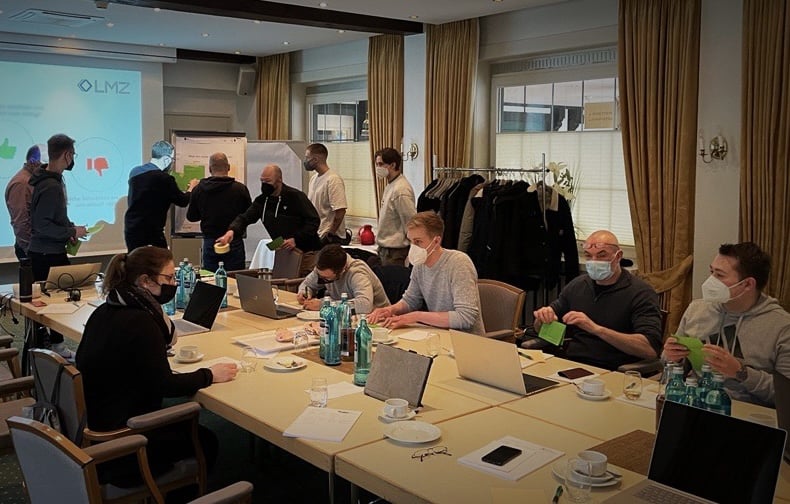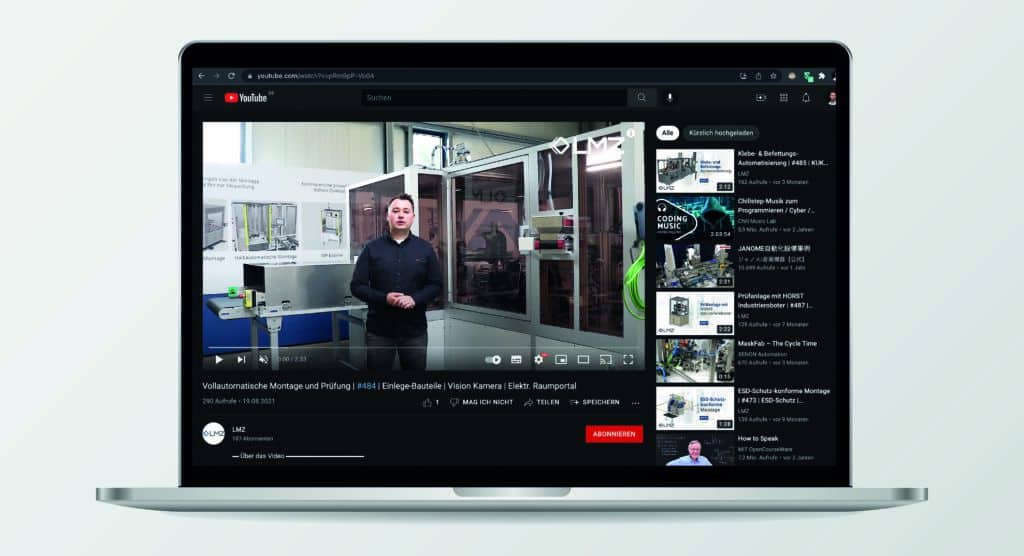B2B Marketing Guide for Small and Medium-sized B2B-Companies
Your 8 Point Guide: A kick start From Zero to Hero
No time? Read Summary
Table of Contents
Subscribe to our Newsletter and Learn B2B Marketing.
This is a story of Torben Fangmann on how he kick started B2B marketing from zero to hero.
To make sure you will get what you want, here’s a small list of things I will NOT talk about in the following chapters:
- No hacks for instant growth.
- No recommendations for the perfect marketing channel.
- No 1-to-1 guide to success.
You get an entirely realistic view of starting B2B marketing when there is an altogether green field. Our goal is to build a stable base to create sustainable success, even if your team is small and your budget is even smaller.
Let’s go!
My first day in the new company
Imagine a young marketer who wants to make a name for himself. My first day in the new office was full of enthusiasm. I wanted to get started. I tried to implement all the great marketing stuff I learned: just me, a blank sheet of paper, and my big chance to show everyone.
Then, there was still this blank sheet of paper on the second day. I just didn’t know where to start. I learned incredible things about Content Marketing, Customer Experience, and Social Media. But no one told me how to get the ball rolling.
Slowly my mind turned from “Yeah, let’s do this!” to “How the hell am I supposed to do this?”.

Torben Fangmann, B2B-Marketing Manager at LMZ © T. Fangmann
The big learning: Use your strengths!
Today the ball rolls. Today I can implement my ideas around Content Marketing, Customer Experience, or Social Media. But the start was far from easy. There were many moments when I compared us to big companies and thought: How will we manage what they do with their fifty-people-teams and million-dollar-budgets? But this isn’t the right way.
My most central learning in this time was: Use your strengths! Don’t focus on the things you can’t change anyway. You won’t have a fifty-people-team, and that’s okay. You won’t have a million-dollar budget, and that’s okay. I learned how to use our strengths as a medium-sized mechanical engineering company.
It can be summarized in eight essential steps:
- Make marketing a management topic.
- Unite the people.
- Set the right benchmarks.
- Give it a face and a personality.
- Generate quick wins.
- Use your network.
- Grow organic.
- Work for the process.
1. Make marketing a management topic
My most excellent marketing lecturer always used to say: “Marketing is Management. That’s everything you need to know.” He was right. If you want to create an impact for your company, marketing has to be a management topic. This means that the management board also has to deal with marketing. Why? Well, there are several reasons for this:
- Common understanding of goals: alignment of corporate goals and marketing goals.
- Direct contact to show the relevance of activities and get budgets.
- Support from the top will help you motivate other employees.
- Especially in small-sized companies, the company, and the brand are shaped and embodied by no one more than the management board itself. You’ll need them for good marketing.
Your strength: In small and medium-sized companies, you usually have much better chances to reach the management level directly with your requests. Give it a try. In my first week, I was able to fix an appointment with our CEO to present my thoughts and ideas for our marketing to him. It wasn’t about topics, formats, and channels. It was mainly about how I envision the collaboration between marketing and the other departments so that we would get a working marketing system up and running. After the meeting, I had synchronized my plans at the highest level and was ready to prepare a kick-off meeting. PS: I’m pretty lucky. It doesn’t have to be the CEO in all cases. Have your view on which persons make sense for you to present your ideas.
2. Unite the people
Time jump: We are in the marketing kick-off meeting. Who is sitting at the table? I had a simple plan: Bring together a group of people, as diverse as possible. Starting with customer-facing colleagues like sales engineers, project managers and programmers, and mechanics.
Your strength: In small and medium-sized companies, you usually have a much more direct line to the various departments, even if you don’t work directly with them.
I’m sure some of my selected colleagues were wondering what they were doing in a marketing meeting. The reason is quite logical: Every person at this table somehow has contact with our customers. Some more than others, that’s true. But every person is a touchpoint for the customer. Every person interacts with the customer. And every person has their own customer knowledge and experiences that need to be brought together. One of the biggest problems of large companies is bringing together customer knowledge within their complex structures. So let’s take advantage of our manageable company size.
But a “knowledge hub” wasn’t my only goal. Even if I was the only full-time marketing manager, I knew that marketing only works as a team. I’ll need help every day – sometimes in the form of feedback, sometimes in the form of technical know-how, sometimes in the form of a person for a video shoot.
The problem is that marketing is not particularly popular in many hardcore B2B companies. The only way to create a sort of intrinsic motivation in the people is to let them participate. They need to understand the goals and the reasons.

The team of LMZ is working on a strategy for 2022 © Torben Fangmann on LinkedIn
3. Set the right benchmarks
I had built up a small, interdisciplinary marketing team step by step. We had a rough strategy and a filled pool of ideas of what we could do to achieve our goals. However, I didn’t want to take random steps and then hope that any of it would work. What I needed were benchmarks – suitable benchmarks.
I often see people setting benchmarks that have almost no relation to their own business. The industry giant, the digital pioneer, or at worst, some marketing gurus on social media who have nothing to do with your industry at all. As I said, we are a medium-sized mechanical-engineering company. Perfect benchmarks and best practices are not waiting at every corner. But it’s worth looking for them.
After extensive online research, I found a couple of good websites, YouTube channels, blogs, and LinkedIn profiles. These were not exceptional companies, but they did certain things very well. And in one thing, they were all the same: They were tangible. That was extremely helpful in visualizing the journey we can make in marketing.
4. Give it a face and a personality
As I’m sure you’ve already noticed, I put a lot of effort into bringing the entire team along for the journey. It’s an extra effort that pays off in the long run because your colleagues are the ones who give the company a face. The days when the marketing department alone was responsible for corporate communications are long gone. As I said: Mostly everyone in the company is a touchpoint to the customer. This means that everyone is building the essential currency in B2B: Trust.
Who do you think customers trust more? Some engineering company, or the engineers and the programmers who personally care for their needs?

LMZ Case Study with project manager on YouTube © YouTube
Mockup: Background vector created by rawpixel.com – www.freepik.com
Your strength: Personal, direct service has always been part of the DNA of small and medium-sized companies. Often locally grown, companies still advertise with customer proximity. Your opportunity is not just to promote it but also to integrate personality into the customer journey. Doing instead of talking.
A CEO who is a direct contact for prospects via LinkedIn. Or a project manager who proudly presents his new customer project on YouTube. There are a variety of ways to put a face to your business.
5. Generate quick wins
It’s a hard truth that every B2B marketer must admit: Sustainable marketing takes time. That’s okay. You have all the key stakeholders on board. You can establish realistic expectations. Nevertheless, quick wins are enormously valuable in keeping motivation high even after initial enthusiasm.
Your strength: You can score quick wins very well if you start at zero. We celebrated our first 100 followers as if we had just won the Social Media Championship. Of course, this is only a small step. But it is a significant step in the right direction.
Online and social media channels are predestined for quick feedback. You can use this to communicate quick wins within the company early. Don’t forget: People often put a lot of passion into their work, especially in technical professions. Now imagine how thrilled they will be when their results receive their well-deserved applause externally as well.
For example, a very innovative customer project of ours was published in the blog of a partner company. The reach was not only very valuable from a marketing point of view but was a well-deserved award for the entire project team.

Torben Fangmann and LMZ celebrating first 100 followers in a LinkedIn-Video © Torben Fangmann on LinkedIn
6. Use your network
Marketing is teamwork, and you have a much bigger team than you think. Collaboration applies not only within your company but also beyond the company boundaries. When I talk about “network”, I don’t necessarily mean a vast contact list on LinkedIn. Instead, I target each company’s purely organic business network: Customers, suppliers, partners, and other stakeholders.
Your strength: Even if you are a small company yourself, in most cases, you work with a select range of small, medium, and even large companies. All of these companies are potential members of your marketing team.
Honestly, I learned about this gamechanger the hard way. Despite all the quick wins, our reach to relevant target groups quickly came up against its natural limits. So I asked myself the simple question: Who benefits when we do good marketing? I’m sure that you and your company also have stakeholders who benefit from your marketing success. It’s worth talking to these people.
Importantly, sustainable marketing collaborations are, of course, a give and take. But what can you bring to the table? Well, quite a lot! First of all, there are many good ideas and incredible commitment to put these ideas into practice. You’ll be surprised at the doors this fact alone will open. After that, transparency is critical: you don’t bring big budgets or reach the collaboration. But you do get things like execution power or a second perspective, which can sometimes be the deciding aspect of turning good content into great content.
When collaboration works, cross-company content pieces or campaigns can be your tool to take your marketing to the next level.
7. Grow organicly
It can be frustrating. You’re working hard on strategy, quality content, and your marketing channels, yet you don’t seem to be getting forward. Every marketer is at this point at some time. Now one thing is incredibly tempting: paid media.
Don’t get me wrong: Paid media is an essential part of a well-functioning marketing guide. But you shouldn’t make your success too dependent on it because the big downside to paid success is that it will be gone just as quickly as before if you stop paying.
I follow the philosophy: Focus on your own channels first. You can push them with paid media, but the end goal must always be to grow your own media. Then, if you do a good job, you will gradually achieve the king medium: Earned Media.
That’s the order I follow. So if your paid media helps grow your organic reach and, in the best case, generates earned media, then it’s worth it in the long run – not just for the pay period. Because the fact is: You will never be able to hold a candle to the big players when it comes to payment alone.
8. Work for the process
When I initially presented my thoughts to our CEO, I set the stage: We weren’t talking about this or that KPI; we were talking about a working marketing system. From the beginning, it was clear. The process is our success. Every step that further develops our marketing guide is a success.
Of course, we will not achieve every marketing goal. We will miss more goals than we achieve. But we will learn something from every step we take. Fail fast, learn faster. Looking back, the steep learning curve was the highest good – for me personally, but especially for us as an organization.
Your last strength: As a small business, you’ll find it much easier to set up agile processes in marketing. You don’t have to break up old structures and turn dusty processes upside down. Use that by actively driving agility in your company – with daily meetings, regular retrospectives, and everything else that goes with it. Then you can fail fast and learn faster.
Honestly, this is the most crucial step because all the other tips I hopefully could give you in this article came from this learning process.
Summary
If these 8 marketing guide steps seem super smart to you, that’s what I wanted to achieve, of course. The truth is: behind every bright tip is at least one fail and one big learning. If you create an e-book that gets 10 downloads, that hurts. That doesn’t feel good when you put out the first social media post and get 35 views.
So my most important message to you is: Stay tuned! We – the B2B marketers in small- and medium-sized B2B companies – have an enormously important task, called: the big, green field. We have to work with what we have. And let me tell you: it works.
Make marketing a management topic. Unite the People. Set the right benchmarks. Please give it a face and a personality. Generate quick wins. Use your network. Grow organic. And work for the process. You have everything you need if you use your strengths.
All that is left for me is to wish you every success and, above all, fun on what is sure to be a fascinating journey.
Trust me; it will be worth it.
3 Comments
Leave A Comment
You May Like the Following Articles
B2B Agricultural Machinery Marketing
Selling tractors, harvesters, or plows isn’t a quick process. Buyers take time, involve multiple decision-makers, and require a solid financial commitment. This is a full guide on B2B agricultural machinery marketing, including real-world examples from John Deere and Kubota.
B2B Construction Machinery Marketing
This is your guide to create a B2B marketing construction machinery roadmap + 3 Examples. Marketing in the construction machinery industry is complex but essential. Unlike consumer goods, purchasing decisions for heavy equipment like excavators, bulldozers, and loaders involve multiple stakeholders, long sales cycles and significant investments. This article provides a structured approach to B2B marketing for the construction machinery industry.
B2B Fintech Marketing
B2B fintech marketing promotes financial technology products to other businesses. It’s different from consumer marketing because the target group is companies like banks, insurance firms, and financial institutions. In this article, we explore the foundations of B2B fintech marketing. We look at key strategies, challenges, and how to measure success. We also discuss future trends that will shape this industry.
B2B Manufacturing Marketing
B2B manufacturing marketing involves promoting products and services from one business to another within the manufacturing sector. Key Points are: Complex Buying Process, Emphasis on Relationships, Technical Focus. This blog post will explore the unique aspects of B2B manufacturing marketing, its challenges, and effective strategies for overcoming them.
Build a B2B Marketing Funnel
Build a B2B marketing funnel requires 5 steps: creating a customer journey, mapping marketing channels, building a multi-touch attribution model, establishing and measuring KPIs, and constantly adapting the funnel. Read how to do this and learn that marketing and sales alignment are essential.
First 90 days for a B2B CMO
In this guide, I’m going to share with you 11 steps to take in the first 90 days of your cadence if you join a B2B company with a high ACV product as a new CMO. As a new chief marketing officer in a B2B company, it's important to hit the ground running and establish a strategy for aligning marketing and sales efforts.
B2B vs B2C Marketing
B2B marketing focuses on marketing strategies, tactics, and content tailored to promote products or services to other businesses. On the other hand, B2C marketing uses strategy and tactics to market directly to consumers. B2B and B2C marketing share similar principles but differ in various aspects.










“Great insights on crafting an effective B2B sales pitch! The breakdown of strategies is practical and easy to apply, especially the emphasis on understanding customer needs. This guide is incredibly helpful for anyone looking to refine their pitch and build stronger client relationships. Thanks for sharing!
Your insights are greatly appreciated. I look forward to continuing to learn from your expertise and am excited to see what new knowledge you will share next. Thank you once again for your invaluable contributions.
Inspiring story. Thanks for sharing.